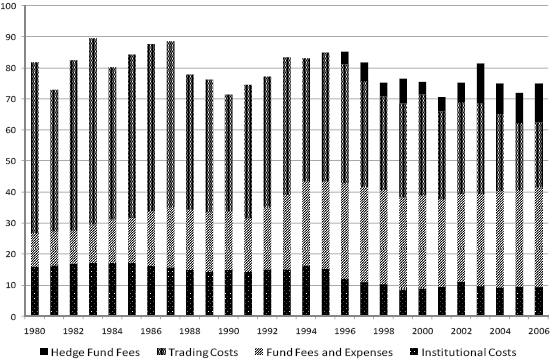Just how much do investors in U.S. equities pay for the hope of beating the market? In his April 2008 paper entitled “The Cost of Active Investing”, Kenneth French estimates the cost of active investing in the U.S. stock market as the difference between the total cost of investing and an estimate of the cost if everyone invested passively. He constructs the total cost of investing as the sum of four components: (1) fees/expenses investors pay for open-end, closed-end and exchange-traded funds; (2) investment management fees for institutional investors; (3) fees investors pay for hedge funds and funds of hedge funds; and, (4) costs all investors pay to trade. Using data for investing costs and market returns during 1980-2006 for NYSE, Amex and NASDAQ stocks, he concludes that:
- The average aggregate annual cost of active investing over the sample period is 0.67% of total market value (an average total actual cost of investing of 0.79% minus an estimated hypothetical cost of passive investing of 0.12%).
- While the cost of active investing is fairly stable over time, the components vary considerably as investors shift from direct trading to asset management (see the chart below). This shift arguably increases competition for alpha, even while trading costs fall dramatically, as an expanding group of professional investors seek to exploit a declining pool of “mistakes” by amateurs.
- Assuming (perhaps optimistically) a real return on U.S. equities of roughly 6.7%, the aggregate cost of active investing represents roughly 10% of real returns ($102 billion in 2006).
The following chart, taken from the paper, tracks the shares of the four components of the total cost of investing during 1980-2006 for NYSE, Amex and NASDAQ stocks. The total cost declines modestly from 0.82% of total market value in 1980 to 0.75% in 2006, with an average total cost per year of 0.79%. The cost of trading falls substantially. A dramatic increase in fund investments more than offsets a moderate decline in typical fund fees/expenses. A shift by institutions toward passive strategies and a reduction in institutional management fees lower average cost. Fees on U.S. equity-related hedge fund assets grow dramatically from 1996 to 2006.

In summary, the average investor in U.S. equities could boost annual returns by roughly 0.67% by switching from an active strategy to a passive one.